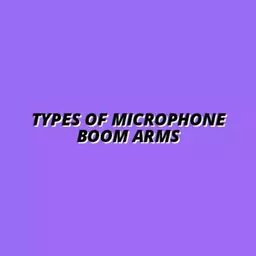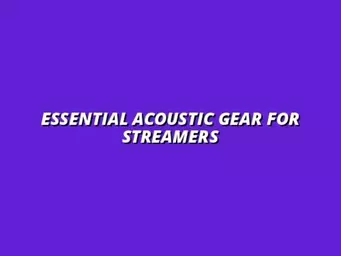High-quality audio is the backbone of any successful streaming experience. Did you know that a well-organized audio setup not only enhances sound quality but also streamlines your workflow? Mastering hidden XLR routing is the key to transforming your streams from mediocre to exceptional!
What You Will Learn
- The critical role of audio quality in keeping your audience engaged and enhancing your professionalism.
- How hidden XLR routing can reduce clutter, minimize interference, and create a visually appealing workspace.
- Troubleshooting common hidden XLR routing issues to maintain optimal audio quality during streaming.
- Evaluating hardware and software solutions for effective audio management and routing.
- Techniques for controlling what you hear versus what your audience hears for a more immersive experience.
- The importance of selecting high-quality microphones tailored to your streaming needs.
Key Benefits of Hidden XLR Routing
Understanding the advantages of hidden XLR routing can significantly enhance your streaming experience. Below are the notable benefits represented visually.
Clean Aesthetics
Tidy up your workspace, making it visually appealing.
Reduced Interference
Minimize unwanted noise and hum from cables.
Ease of Setup
Streamline connections for a hassle-free configuration.
Understanding Streaming Setups with Hidden XLR Routing
When it comes to streaming, the audio quality can make or break the experience! High-quality sound helps keep your audience engaged and provides a professional edge to your content. As someone deeply passionate about audio setups, I can tell you that investing time in understanding hidden XLR routing is key to achieving that clean and polished sound you desire.
Hidden XLR routing allows for a neat and organized workspace, reducing clutter, and minimizing potential audio interference. Think of it as creating a streamlined path for your audio signals, ensuring that your sound remains crisp and clear. With platforms like Twitch and YouTube being competitive, having a well-structured audio setup can truly elevate your streaming game!
To ensure your audio setup is top-notch, consider exploring desktop audio cable solutions that can help you manage your cables effectively and maintain a clean workspace. This is especially beneficial when implementing hidden XLR routing.
The Importance of Audio Quality in Streaming
Have you ever tuned into a stream with poor audio quality? It can be frustrating! Here are a few reasons why audio quality is crucial for streamers:
- Engagement: Good audio keeps your audience focused on your content.
- Professionalism: Clear sound reflects quality in your overall production.
- Communication: Quality audio helps convey your message effectively.
As a streamer, your audience deserves the best experience possible. By prioritizing audio quality and implementing hidden XLR routing techniques, you can ensure that your streams stand out in a sea of content. It’s about more than just sound—it’s about creating an immersive experience that keeps viewers coming back for more!
💡 Planning an echo-free audio desk? Start with desk setup inspiration and acoustic routing. 👉 Explore the Setup Ideas Guide
Why Choose GoXLR for Your Streaming Setup?
If you're serious about streaming, the GoXLR is a fantastic choice! This audio interface offers incredible features tailored for live streaming, making it a favorite among professionals. With its intuitive design, you can quickly adjust audio levels, mute channels, and even add sound effects on the fly.
The GoXLR provides seamless integration with your streaming setup, allowing for easy hidden XLR routing. You can connect multiple audio sources while maintaining a clean workspace, which is what we at Tidy Audio Desk are all about! This device not only enhances your audio quality but also transforms your streaming experience. Speaking of enhancing your setup, consider looking into cable management solutions for your desk lamps to ensure a tidy workspace.
Benefits of Hidden XLR Routing for Streamers
Hidden XLR routing can revolutionize your streaming setup in several ways. Let’s take a look at some of the key benefits:
- Clean Aesthetics: Tidy up your workspace, making it visually appealing.
- Reduced Interference: Minimize unwanted noise and hum from cables.
- Ease of Setup: Streamline connections for a hassle-free configuration.
With hidden XLR routing, you can focus on what really matters—creating amazing content for your audience! Plus, it makes for a more enjoyable streaming environment, where everything feels organized and purposeful. Are you ready to dive deeper into optimizing your setup?
Quick Summary
Here's a brief recap of the key points discussed so far:
- Understanding hidden XLR routing can significantly enhance your streaming audio quality.
- Prioritizing audio quality helps engage your audience and reflects professionalism.
- The GoXLR audio interface simplifies hidden routing while improving sound management.
- Regular monitoring and troubleshooting can prevent common audio issues in your setup.
Troubleshooting Common Hidden XLR Routing Issues
Troubleshooting your audio setup can sometimes feel like a puzzle, but I’m here to help you piece it together! Hidden XLR routing is fantastic for keeping your workspace tidy, but it can lead to some common issues that might arise during your streaming sessions. Let's explore how to identify and fix these routing errors to keep your sound crisp and clear.
First, understanding how to monitor your audio routing setup is crucial. You can do this by regularly checking your mixer levels and audio interface settings. If you notice any distortion or silence, it could be a sign that your signals aren’t properly routed. Remember, even small changes can impact your overall audio quality, so keep an eye on your levels!
Before diving into troubleshooting, let's address some frequently asked questions that can provide immediate help:
Frequently Asked Questions
What should I do if my audio cuts out during a stream?
First, check all cable connections to ensure they are secure. Then, verify your software settings to confirm that the correct inputs are assigned. If the problem persists, test each component individually to isolate the issue.
How can I improve the sound quality without spending too much?
Start by optimizing your microphone placement and reducing background noise. You can also explore free software tools for audio management, such as VoiceMeeter, to enhance your control over audio settings.
Are there any free tools available for audio management?
Yes, several free tools can significantly improve your audio management. VoiceMeeter is a popular option for comprehensive audio control, while OBS Studio offers essential features for managing streaming audio and video inputs.
- Check for any muted channels.
- Ensure cables are securely connected.
- Use software tools to visualize your audio flow.
Documenting complex routing configurations can also save you a lot of headaches. Consider creating a simple diagram that outlines where each cable goes and how it connects to your devices. This way, if something goes wrong, you can quickly refer back to your notes!
Identifying and Fixing Routing Errors
It’s essential to recognize the signs of routing errors early on. Here are some common symptoms you might experience:
- Audio cuts in and out unexpectedly.
- Different audio levels between your voice and game sounds.
- Static or unwanted noise in your stream.
To further enhance your audio quality, consider investing in stream-ready mic setup essentials. These can significantly reduce noise and improve clarity.
- Recheck all cable connections and ensure they are correctly plugged in.
- Examine your software settings to confirm that inputs are correctly assigned.
- Test each component individually to isolate the problem.
Comparative Analysis of Hardware and Software Solutions
Finding the right solutions for hidden XLR routing can often be a matter of hardware versus software. Each has its benefits, and understanding these can help you make the best choice for your setup. Let’s look at some options:
Evaluating Different Hardware Options for Hidden Routing
When considering hardware, here are a few key components to evaluate:
- Quality of XLR cables: Better cables often result in clearer sound.
- Audio interfaces: Make sure it has good compatibility with your gear.
- Mixers: Look for models that offer flexible channel routing.
Upgrading your hardware can yield significant improvements in your audio quality. If you’ve invested in your streaming setup, don’t hesitate to consider a hardware refresh!
Third-Party Software Tools for Enhanced XLR Routing
In addition to hardware, software can also play a pivotal role in optimizing your audio routing. Here are some notable software tools:
- Virtual Audio Cable: It allows you to create virtual audio streams for better routing.
- VoiceMeeter: A free tool that enables comprehensive audio control.
- OBS Studio: This is essential for managing your streaming audio and video inputs!
Using these tools can help you achieve more control over your audio setup, allowing for a seamless streaming experience. At Tidy Audio Desk, we’re always on the lookout for the best solutions to enhance your audio performance! For some extra tips about organizing your cables, consider looking at these under desk cable management ideas.
Engaging Your Audience with Quality Audio
With the foundation of your setup in place, it’s time to focus on how to engage your audience through quality audio. Clear sound not only elevates your content but also keeps your viewers coming back for more. So, how can you ensure you control what you hear versus what your audience hears?
Controlling What You Hear vs. What Your Audience Hears
Understanding the difference between your audio mix and what your audience experiences is key. Here are some strategies to enhance this:
- Use selective channel routing: This allows you to customize what you hear versus what your audience hears.
- Monitor your audio with headphones to catch issues in real-time.
- Regularly check your streaming settings to ensure optimal quality.
By implementing these techniques, you'll create a more immersive experience for your viewers. High-quality audio is one of the easiest ways to elevate your streaming presence!
Utilizing High-Quality Microphones for Better Sound
Choosing the right microphone can significantly impact your audio quality. Here are a few types to consider:
- Dynamic microphones: Great for reducing background noise.
- Condenser microphones: Excellent for capturing a wide range of frequencies.
- Lavalier microphones: Ideal for hands-free use, especially during interviews.
Investing in a high-quality microphone is worth it! It’s one of the best ways to ensure your audience hears you loud and clear. At Tidy Audio Desk, we believe that every detail matters when it comes to audio performance.
Frequently Asked Questions on Streaming Setups with Hidden XLR Routing
As we wrap up, let’s tackle some common concerns you might have about streaming setups with hidden XLR routing. Here are a few frequently asked questions:
- What should I do if my audio cuts out during a stream?
- How can I improve the sound quality without spending too much?
- Are there any free tools available for audio management?
Don’t hesitate to reach out for specific solutions tailored to your setup! I’m always here to help you fine-tune your audio environment.
Common Concerns and Quick Solutions
To wrap things up, here are quick answers to some common concerns:
- If you experience audio lag, check your buffer settings in your audio interface.
- For static noise, ensure all cables are shielded and avoid crossing them with power cables.
- If you hear echoes, verify that your mic is not too close to your speakers.
By addressing these issues promptly, you can keep your streams sounding professional and clear. Remember, a polished audio setup speaks volumes to your audience!
Invitation to Share Your Experience
Now that you’ve gathered some insights, I’d love to hear about your experiences with hidden XLR routing! Have you faced any challenges? What solutions did you find that worked best for you?
Encouraging Interaction with the Streaming Community
Sharing your setup and customizations can not only help you but also inspire others in the community. Let’s create a space where we can learn from each other!
- Post photos of your audio workspace on social media.
- Join forums or groups focused on audio setup discussions.
- Engage in conversations about the latest audio technologies and solutions.
By joining the ongoing conversation on audio quality in streaming, we can all aim for excellence in our setups! Let’s tidy up those workspaces and keep pushing the boundaries of what’s possible in our audio journeys!
Recap of Key Points
Here is a quick recap of the important points discussed in the article:
- Prioritize Audio Quality: High-quality sound significantly enhances viewer engagement and reflects professionalism.
- Utilize Hidden XLR Routing: This technique helps maintain a clean workspace, reduces interference, and simplifies setup.
- Choose the Right Equipment: Opt for quality microphones and audio interfaces like GoXLR to improve your audio performance.
- Troubleshoot Effectively: Regularly monitor your audio setup, check connections, and document routing configurations to swiftly resolve issues.
- Engage Your Audience: Use selective channel routing and monitor audio closely to create an immersive experience for viewers.










